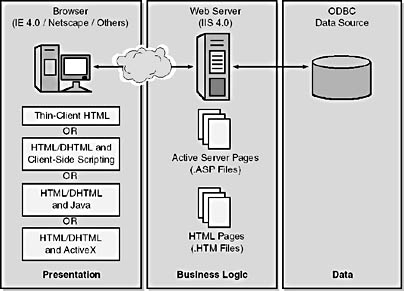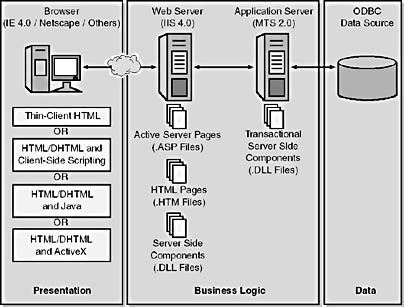Web Architectures
Prior to diving into the details of building n-tier applications using Visual InterDev 6.0, Visual Basic 6.0, and other tools, let's take a quick look from the 30,000-foot level at how these various n-tier applications can be wired together.
Within a large corporation, you can utilize several different models for your Web architectures based upon the demands placed upon each specific application. For example, you can use a three-tier architecture with server-side components and MTS for part of your external Internet site. However, you might use a simpler two-tier architecture on your Intranet site to speed the development process and reduce the application complexity. When deciding upon the appropriate technical architectures to use for your applications, keep in mind the application requirements: functionality, scalability, performance, security, reliability, manageability, and maintainability.
Two-Tier Architectures
The basic two-tier architecture for a Microsoft Web solution involves the browser, the Web server, and the database. This may well involve Internet Explorer, IIS, and SQL Server. On the browser end, you are free to deliver plain HTML or Dynamic HTML (DHTML) for breadth of deployment and Java applets and/or ActiveX controls for depth of functionality. Of course, this is a trade-off and depends upon your target audience and the required sophistication of your user interface. If you are trying to reach the largest audience possible (with a variety of browser types) on an Internet or extranet site, you might want to deliver plain HTML. If you know your target audience, perhaps on an intranet site, or are in the position to dictate browser requirements and you need a richer GUI than HTML allows, you might want to take advantage of DHTML, Java applets, or ActiveX controls.
On the server side, the only real stake in the ground is that you must be running Windows NT 4.0 and IIS 4.0 to execute the ASP Web pages you have generated from Visual InterDev. This is changing somewhat, however, as vendors such as Chili!Soft produce software that can run ASP code on UNIX platforms such as Sun Solaris. The database that you interface with can be any ODBC-compliant database. Figure 17-2 shows the typical two-tier Web architecture.

Figure 17-2. Microsoft two-tier Web architecture.
Three-Tier Architectures
The three-tier architecture for a Microsoft Web solution takes the basic two-tier architecture and extends it by adding server-side components. These server-side components are COM components that contain nonvisual business logic. They can be either nontransactional or transactional. Transactional components are placed under MTS, which manages the transactions and handles multithreading, security, database connection pooling, and so on.
Three-tier architectures generally take longer to develop and test than two-tier architectures, but they provide a more robust infrastructure for running business-critical Web applications. As noted earlier, middle-tier components can also be reused across different applications or even across different channels. Application maintenance is also simplified since the business logic is more likely to be contained within a single component. Figure 17-3 shows the typical three-tier Web architecture.

Figure 17-3. Microsoft three-tier Web architecture.
The Visual InterDev 6.0 Toolbox allows you to access several prebuilt components that extend ASP to make an enormous impact. As we shall see in the following chapters, you can also write your own components using Visual Basic, Microsoft Visual C++, Microsoft Visual J++, or any other development tool that supports creating Active Server components. Also, just as ActiveX controls are proliferating all over the Web, many Active Server components are now available for purchase from third-party software vendors. These software vendors are incorporating functionality that pushes the extremely flexible architecture of Active Server components to the limit.
EAN: 2147483647
Pages: 143